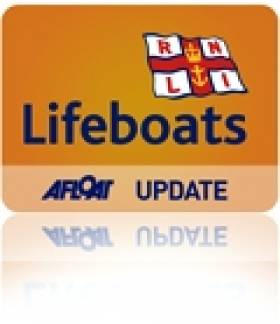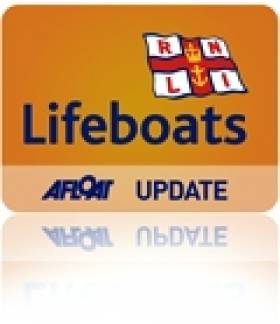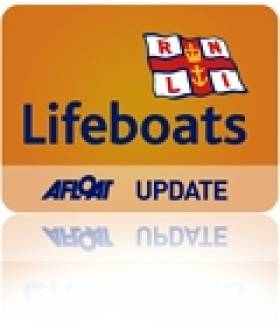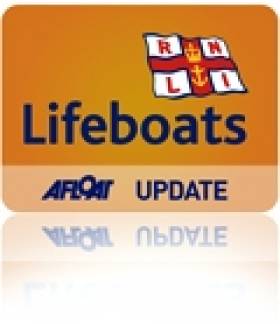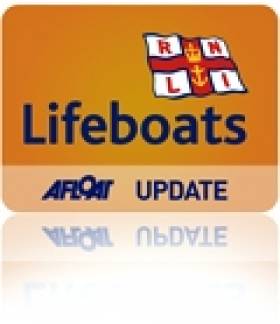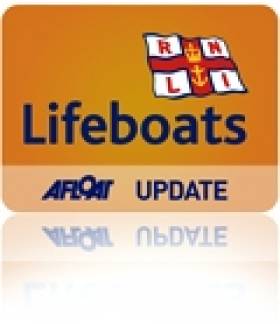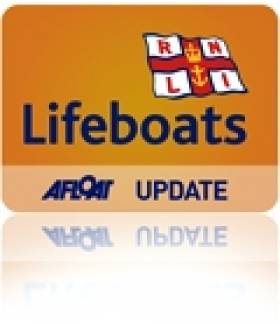Displaying items by tag: Lifeboats
#RNLI - A busy weekend for the volunteer crew with Lough Ree RNLI began on Friday evening 25 July when the lifeboat launched at 6.30pm for a cruiser with engine problems near marker no 9 north of the Quaker Island.
When the lifeboat arrived on scene it found the 34-foot cruiser was at anchor. There were two adults on board and the engine had overheated.
The casualty vessel was towed to Ballyleague and the lifeboat was back on station and ready for service at 8.40pm.
Lough Ree's lifeboat next launched at 7.22am on Saturday morning for a cruiser aground near the Black Islands.
On arriving on scene the lifeboat crew found two adults and four children on board. They were taken on board the lifeboat and dropped off at Quigley's Marina, while a rescue boat later arrived on scene to take care of the cruiser.
The lifeboat crew had just left the station when another call out was received at 9.52am for a cruiser aground off Inch McDermott.
There were six people on board the cruiser, which was eased off the rocks by the lifeboat. The cruiser was then able to proceed under her own power.
At 6.55pm the same day, a callout was received for a large cruiser aground on the Hexagon Shoal with three adults and three children on board.
One female adult and the three children were transferred to the Lough Ree Yacht Club safety RIB, which had been standing by the casualty, and taken to Hudson Bay.
The cruiser was found to be taking water and the lifeboat returned to base to get pumping equipment. The casualty was pumped and towed to Quigley's Marina. The lifeboat was back on station and on standby at 8.50pm.
Lough Ree RNLI lifeboat operations manager Damien Delaney said of the busy weekend: "The recent spell of good weather has brought large numbers of people to the water, many for the first time in years, and this, coupled with the low levels in the river and lake, makes extra attention to the markers and navigation channels necessary."
All this activity comes in advance of the news that the current lifeboat on station at Lough Ree, Dorothy Mary B728, which has been in service since the station began operations over two years ago, is to be replaced.
Dorothy Mary was commissioned in 1996 and has now reached her retirement age. She will be leaving the station this coming week.
Her replacement is to be the Eric Rowse B772, which was commissioned in 2000. She previously served at the St Catherine station in Jersey from 2001 to 2010, when she joined the reserve fleet.
She is the same class of lifeboat as Dorothy Mary, an Atlantic 75, and is due to arrive in the coming days.
#RNLI - Summer certainly hit Ireland's North Coast with a bang this week as temperatures topped 27 degrees, and the volunteer crew of Portrush RNLI experienced one of their busiest weeks.
On Monday 21 July, the all-weather lifeboat William Gordon Burr was launched to a motor cruiser at Lough Foyle that had run foul of a chain of lobster pots.
The crew deployed the Y boat off the lifeboat to try to free the ropes from the propeller. The mission was successfully accomplished and the cruiser sailed off to Greencastle to get checked out.
Next out was the inshore lifeboat David Roulston (Civil Service No 52), which had two callouts on Wednesday 23 July, the first around 11am to a small boat who got into difficulty at Dunluce Castle.
Luckily for the boat, a local fisherman arrived on scene at the same time as the lifeboat and towed the boat to Portballintrae.
The next callout was at 9pm, and again another local boat assisted with the small boat who had got into difficulty.
On Thursday morning at 5am, the crew of the all-weather lifeboat were paged once again. This time it was a callout to Ballycastle to assist with the search of a young person who was reported missing.
The coastguard helicopter was deployed and they soon located the young female who was successfully airlifted to hospital.
"So far this has been one of our busiest seasons as we have experienced an unprecedented good summer so our volunteer crew have been kept working," said Judy Nelson, volunteer lifeboat press officer for Portrush RNLI.
"We love to see people coming to Portrush to take advantage of everything the North Coast has to offer, but would ask people to exercise caution when on the beach.
"The RNLI Lifeguards are on patrol on all the beaches and are delighted to offer advice to visitors about safe bathing. The RNLI website will also give all the advice you need, whether it is about swimming, kayaking, surfing or boating."
Lough Derg Lifeboat Assists Two On Grounded Cruiser
#RNLI - Lough Derg RNLI's lifeboat launched last night (Saturday 26 July) to assist two people on board a cruiser aground at Drominagh, at the northern end of Lough Derg.
Valentia Coast Guard requested the launch at 9.45pm and the lifeboat left station at 9.55pm with helm Peter Clarke, Ger Egan and David Moore on board.
Winds were south westerly, Force 2 to 3, and visibility was good but with nightfall approaching.
When the lifeboat arrived on scene, it found the two people on the cruiser to be safe and unharmed, and wearing their lifejackets. An RNLI volunteer checked the boat for damage and, when he was satisfied it was not holed, he set up a tow.
The lifeboat took the cruiser off the rocks and out to safe water, where the engine, props and steering were found to be in working order.
The cruiser, under her own steam, and with an RNLI crew member still on board, made way to Terryglass Harbour. The lifeboat remained alongside and helped to secure the boat in Terryglass.
Clarke praised the crew of the boat for remaining calm and calling for assistance as soon as they recognised they had a problem.
He also advised "all boat users to study their charts before setting out, and to stay within the navigation buoys on the lake."
Wicklow Lifeboats Rescue Five From Grounded Vessel
#RNLI - Both Wicklow RNLI lifeboats launched after 4.15pm yesterday afternoon (Thursday 24 July) to assist a vessel aground near Travelahawk beach south of Wicklow Harbour.
The alarm was raised after the owner of a motor boat put out a distress call on marine VHF radio to say his vessel was aground on rocks and they required assistance.
The inshore and all-weather lifeboats were on scene minutes later and found there were two boats aground.
A lifeboat crew member was transferred onto the boats from the inshore lifeboat to assist with rigging tow lines. The inshore lifeboat then towed a small hire boat with three occupants off the rocks and brought them to safety at Wicklow Harbour.
The larger motor boat was successfully refloated by the all-weather lifeboat crew and towed into Wicklow Harbour, where its two passengers were landed safely at the East Pier.
Wicklow Inshore Lifeboat Rescues Sheep Trapped In Cave
#RNLI - Wicklow RNLI's inshore lifeboat launched at 3pm on Wednesday afternoon (23 July) to rescue a sheep trapped in a cave and in danger of drowning as the tide rose.
Two attempts had already been made to recover the sheep by its farmer, but he was unable to get down the rocks safely, so the lifeboat crew were asked if they could help.
The inshore lifeboat was on scene at 3.35pm at Mizen Head, south of Brittas Bay beach, where the crew successfully retrieved the animal from the cave.
The frightened but uninjured sheep was reunited with its owner a short time later on a nearby beach.
The lifeboat crew on this callout were helm Alan Gouche, Lisa O'Leary and Graham Fitzgerald.
Portaferry Lifeboat Assists Family On Stranded Yacht
#RNLI - Portaferry RNLI received a request to launch their inshore lifeboat at 10.40am this morning (22 July) to the aid of a family on board a stranded yacht.
The lifeboat launched at 10.47am and arrived at the scene just south of Dogtail Point in Strangford Lough, Co Down seven minutes later.
The 13m yacht had run onto rocks where it remained stranded with the two adults and two children onboard until the help arrived.
Weather conditions at the time were very foggy with poor visibility, a Force 2 southerly breeze and calm seas.
When the volunteer crew from Portaferry RNLI arrived, they were assisted by the crew of a local boat, the Cuan Rib, in easing the stranded yacht on board clear of the rocks.
The volunteer lifeboat crew then inspected the yacht for damage at the scene before escorting the vessel and its passengers safely back to Portaferry Marina.
Newlyweds' Surprise Gift To Crosshaven Lifeboat
#RNLI - In a first for Crosshaven RNLI, the volunteer crew welcomed newly married couple Kieran Geasley and Patricia Lenihan to the Cork Harbour lifeboat station.
Geasley, a commercial fishing skipper from Cobh and a former RNLI volunteer at Dunmore East, and Lenihan, from Carrigaline, wanted to make a donation to the RNLI instead of putting wedding favours on the tables at their reception.
Lifeboat helm Kieran Coniry, along with fellow crew Ian O’Keefe and Catherine Levis, welcomed the couple to the station with the traditional bottle of champagne and thanked them on behalf of the RNLI for their generous donation, wishing them a lifetime of happiness together.
In other recent lifeboat news, Rosslare Harbour RNLI volunteers launched their all-weather lifeboat on Friday evening (18 July) to go to the aid of an 8m yacht with a broken rudder.
The yacht was bound for the south coast and was about 1.5 miles north of Rosslare Harbour. Visibility at the time was poor due to sea fog and the wind was a south-easterly Force 3 to 4.
The yacht, which was crewed by a father and his young son, was taken under tow by the lifeboat into the safety of Rosslare Europort.
Howth, Wicklow Lifeboats Aid Vessels With Engine Troubles
#RNLI - Howth RNLI continued a busy week of callouts on Wednesday evening (16 July) when the volunteer crew launched to assist a 27ft motorboat with no power drifting in the vicinity of the Nose of Howth.
The crew was alerted at 6.43pm following a distress call that a motorboat with two crew members aboard was drifting with no engine power at the mercy of the strong tide.
Weather conditions at the time were very good, with a light westerly Force 2 to 3 breeze and good visibility.
The Howth lifeboat, under coxswain Fred Connolly and with five other crew members on board, quickly located the casualty vessel and established a tow line to return the vessel and its occupants to the safety of Howth Harbour exactly an hour after the initial alert.
"The crew of the motorboat did the correct thing to call for help as soon as their vessel experienced engine trouble," said Connolly. "We are pleased that we were able to locate and tow the vessel to safety before it drifted closer to the shore."
Later that evening, Wicklow RNLI launched its all-weather lifeboat Annie Blaker to go to the aid of a 24ft yacht with mechanical problems off the Wicklow Coast.
The alarm was raised after the boat on passage south developed engine problems, With light wind, the yacht was unable to make any headway under sail, so the crew dropped anchor and contacted the Irish Coast Guard for assistance.
Wicklow's lifeboat, under the command of coxswain Nick Keogh, located the yacht – with two adults and a dog on board – one mile east of the Six Mile Point at 11.54pm. Conditions in the area were calm sea and light wind.
Crew member Kevin Rahill was transferred onto the yacht to establish a towline and assist the two sailors. Once the towline was rigged, the yacht was towed back to Wicklow Harbour, where it was safely secured alongside the East Pier by 1am.
Bundoran Lifeboat Helps Six Teenagers Trapped By Tide
#RNLI - Last night (17 July) the volunteer crew of the Bundoran RNLI lifeboat were paged by Malin Head Coast Guard to the aid of six teenagers who had been cut off by the tide at the West End of the Co Donegal town.
Bundoran's lifeboat William Henry Liddington launched just after 8.30pm with four crew on board and were on the scene within two minutes to find the group, who had climbed down to the water’s edge but were unable to make their way back and became trapped by the tide.
The six, none of whom were injured, were helped on board by the lifeboat crew and brought safely back to the station, where they thanked the crew.
Helming the lifeboat on the callout was Dessie Daly, who said: "This was another callout that had a happy ending.
"We thank the member of the public who made the initial emergency call and remind anyone who sees anyone in danger on the coast to call 999 or 112 and don’t assume that somebody else has done it."
#RNLI - Portaferry RNLI launched its inshore lifeboat yesterday afternoon (14 July) to the aid of a man who had suffered a head injury in one of the races during Portaferry Sailing Club’s annual regatta.
The lifeboat launched at 2.36pm and met up with the injured man a few minutes later on board his 12m yacht just off Marfield Bay in Strangford Lough, Co Down.
Weather conditions at the time were cloudy with good visibility, with a Force 2 to 3 southerly wind and calm seas.
After assessing the injured man’s condition, the volunteer crew transferred him into the lifeboat before taking him to Strangford Harbour, where he was then passed into the care of the Northern Ireland Ambulance Service.
Around the same time, RNLI Bangor was launching to investigate reports that children could have been on board an abandoned homemade raft spotted adrift off Ballymacormick Point on the edge of Belfast Lough.
Calm seas and fine weather allowed the lifeboat to proceed at full speed to the search area between Ballymacormick Point and Orlock Point.
After an extensive two-hour search of the area in conjunction with a fishing vessel and a coastguard rescue team, nothing was found.
The search was later terminated when enquiries found that there was a high probability that the raft had drifted from shore during high water.
Michael McKenna, volunteer RNLI helmsman who was involved in the search, took the opportunity to remind all children playing along the coast of the SAFE code: S for spot the dangers, A for always go with a friend, F for find and follow the safety signs and flags and E for Emergency - put up your hand and shout or ring 999/112 and ask for the coastguard.
It was the third callout for Bangor RNLI in three days, after a busy Saturday 12 July that began with a morning request from Belfast Coastguard to assist in the search for an inflatable dinghy.
The dinghy had been spotted by a concerned member of the public at the mouth of Larne Lough. The Bangor volunteer crew joined the Larne RNLI lifeboat in the search for the dinghy and its occupants. The former were quickly on scene and found the dinghy deserted with its engine down and a rope around the propeller.
The name painted on the dinghy hull was passed to Belfast Coastguard who were able to contact the owners. Thankfully, the owners reported that the dinghy had broken free from their vessel and that no one was on board.
The second call of the day came at 11:55am when the Bangor lifeboat launched to rescue four people from a motor boat that had broken down off the oil jetty at Cloghan Point, on the northern shores of Belfast Lough.
On scene, the RNLI crew quickly evaluated the situation and manoeuvred the lifeboat close to the broken-down vessel.
With relatively calm weather conditions, a tow rope was rigged and successfully passed to the motor boat, which was then towed the four miles back to the safety of Bangor Marina.
"Engine failure close to shore could lead to a life-threatening situation," said Bangor RNLI volunteer helmsman Iain Dobie.
"We always urge everyone going to sea to make sure their electrical systems and engine are well maintained and in good working order. A good anchor and chain should always be carried as part of essential safety equipment.
"We are glad the family on board this vessel are now safely ashore," he added.


























